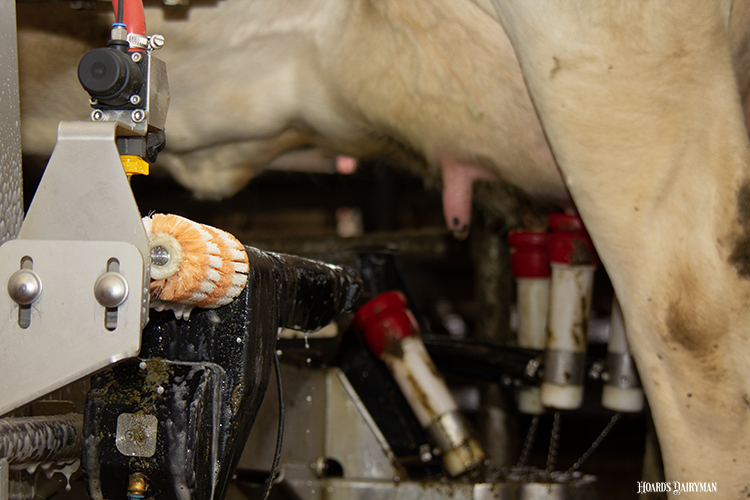
Benefits of robotic milking systems often include lower labor needs, calmer cows, and greater milking frequency and yield. According to Trevor DeVries, a professor at the University of Guelph, there are ways milk quality can also be improved in robotic facilities.
During the May Hoard’s Dairyman webinar, DeVries shared data that showed a rise in clinical mastitis cases, cow level somatic cell counts, and bulk tank somatic cell counts for the first six to 12 months following the transition to a robotic milking system. However, there were no sustained differences in these metrics over a longer period of time.
DeVries said this tells us that the udder health changes seen when switching to a robotic milking facility have little to do with the robots and more to do with the changes in housing and management. This can include stress, hygiene, and cow health factors caused by the environment the cows live in.
For example, cows might be dirtier if they stand in messy alleyways or have to wait around a long time to be milked. DeVries said higher mastitis rates or somatic cell counts might occur in herds where robots were put into older facilities with small stall beds, narrower alleys, or other factors that elevate contamination.
When a cow is dirty, it can cause problems for the machine. That’s because a robot can’t differentiate a dirty udder from a cleaner one like a person might.
One way robots can help milk quality is the ability to do quarter level milking. With this capability, the risk of overmilking is potentially reduced.
DeVries said farms could also use features of robotic milking to improve the dry-off process. “From an udder health and welfare perspective, getting production down prior to dry-off is important to minimize the risk of udder engorgement in the early days post dry-off,” DeVries said. This also helps reduce the risk of early dry period mastitis cases.
In conventional barns, it can be hard to make changes in feeding and milking frequency to help cows taper off prior to dry-off. But in a robotic barn, the feed delivered through the robot can be reduced, which may change a cow’s desire to come to the robot as often to be milked. The milking permissions can also be adjusted to prevent cows near dry-off from milking too frequently.
To learn more about taking care of cows in an automated milking system, watch the May Hoard’s Dairyman webinar, titled “Managing for success with robotic milking systems.” This webinar was sponsored by Galaxy.








